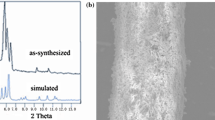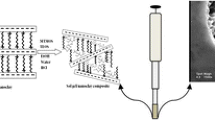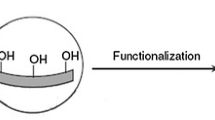Abstract
The fiber coating is the key part of the solid-phase microextraction (SPME) technique, and it determines the sensitivity, selectivity, and repeatability of the analytical method. In this work, amine (NH2)-functionalized material of Institute Lavoisier (MIL)-53(Al) nanoparticles were successfully synthesized, characterized, and applied as the SPME fiber coating for efficient sample pretreatment owing to their unique structures and excellent adsorption properties. Under optimized conditions, the NH2-MIL-53(Al)-coated fiber showed good precision, low limits of detection (LODs) [0.025–0.83 ng L-1 for synthetic musks (SMs) and 0.051–0.97 ng L-1 for organochlorine pesticides (OCPs)], and good linearity. Experimental results showed that the NH2-MIL-53(Al) SPME coating was solvent resistant and thermostable. In addition, the extraction efficiencies of the NH2-MIL-53(Al) coating for SMs and OCPs were higher than those of commercially available SPME fiber coatings such as polydimethylsiloxane, polydimethylsiloxane–divinylbenzene, and polyacrylate. The reasons may be that the analytes are adsorbed on NH2-MIL-53(Al) primarily through π–π interactions, electron donor–electron acceptor interactions, and hydrogen bonds between the analytes and organic linkers of the material. Direct immersion (DI) SPME–gas chromatography–mass spectrometry methods based on NH2-MIL-53(Al) were successfully applied for the analysis of tap and river water samples. The recoveries were 80.3–115% for SMs and 77.4–117% for OCPs. These results indicate that the NH2-MIL-53(Al) coating may be a promising alternative to SPME coatings for the enrichment of SMs and OCPs.





Similar content being viewed by others
References
Arthur CL, Pawliszyn J. Solid phase microextraction with thermal desorption using fused silica optical fibers. Anal Chem. 1990;62(19):2145–8.
Kataoka H, Lord HL, Pawliszyn J. Applications of solid-phase microextraction in food analysis. J Chromatogr A. 2000;880(1-2):35–62.
Lambropoulou DA, Konstantinou IK, Albanis TA. Recent developments in headspace microextraction techniques for the analysis of environmental contaminants in different matrices. J Chromatogr A. 2007;1152(1-2):70–96.
Bermejo AM, Lopez P, Alvarez I, Tabernero MJ, Fernandez P. Solid-phase microextraction for the determination of cocaine and cocaethylene inhuman hair by gas chromatography-mass spectrometry. Forensic Sci Int. 2006;156(1):2–8.
Vogliardi S, Tucci M, Stocchero G, Ferrara SD, Favretto D. Sample preparation methods for determination of drugs of abuse in hair samples: a review. Anal Chim Acta. 2015;857:1–27.
Ouyang GF, Vuckovic D, Pawliszyn J. Nondestructive sampling of living systems using in vivo solid-phase microextraction. Chem Rev. 2011;111(4):2784–814.
Mehdinia A, Aziz-Zanjani MO. Recent advances in nanomaterials utilized in fiber coatings for solid-phase microextraction. Trends Anal Chem. 2013;42:205–15.
Xu JQ, Zheng J, Tian JY, Zhu F, Zeng F, Su CY, et al. New materials in solid-phase microextraction. Trends Anal Chem. 2013;47:68–83.
Liu JF, Li N, Jiang GB, Liu JM, Jönsson JÅ, Wen MJ. Disposable ionic liquid coating for headspace solid-phase microextraction of benzene, toluene, ethylbenzene, and xylenes in paints followed by gas chromatography-flame ionization detection. J Chromatogr A. 2005;1066:27–32.
Herrera-Herrera AV, Angel Gonzalez-Curbelo M, Hernandez-Borges J, Angel R-DM. Carbon nanotubes applications in separation science: a review. Anal Chim Acta. 2012;734:1–30.
Turiel E, Tadeo JL, Martin-Esteban A. Molecularly imprinted polymeric fibers for solid-phase microextraction. Anal Chem. 2007;79(8):3099–104.
Ferey G. Hybrid porous solids: past, present, future. Chem Soc Rev. 2008;37(1):191–214.
Betard A, Fischer RA. Metal-organic framework thin films: from fundamentals to applications. Chem Rev. 2012;112(2):1055–83.
Li JR, Sculley J, Zhou HC. Metal-organic frameworks for separations. Chem Rev. 2011;112(2):869–932.
Lee JY, Farha OK, Roberts J, Scheidt KA, Nguyen ST, Hupp JT. Metal-organic framework materials as catalysts. Chem Soc Rev. 2009;38(5):1450–9.
Yang CX, Yan XP. Application of metal-organic frameworks in sample pretreatment. Chin J Anal Chem. 2013;41(9):1297–300.
Gu ZY, Yang CX, Chang N, Yan XP. Metal-organic frameworks for analytical chemistry: from sample collection to chromatographic separation. Acc Chem Res. 2012;45(5):734–45.
Pocio-Bautista P, Pacheco-Fernandez I, Pasan J, Pino V. Are metal-organic frameworks able to provide a new generation of solid-phase microextraction coatings? - a review. Anal Chim Acta. 2016;939:26–41.
Serre C, Millange F, Thouvenot C, Nogues M, Marsolier G, Louer D, et al. Very large breathing effect in the first nanoporous chromium(III)-based solids: MIL-53 or Cr-III(OH)·{O2C-C6H4-CO2}·{HO2C-C6H4-CO2H}x·H2Oy. J Am Chem Soc. 2002;124(45):13519–26.
Yang CX, Liu SS, Wang HF, Wang SW, Yan XP. High-performance liquid chromatographic separation of position isomers using metal-organic framework MIL-53(Al) as the stationary phase. Analyst. 2012;137(1):133–9.
Llewellyn PL, Bourrelly S, Serre C, Filinchuk Y, Férey G. How hydration drastically improves adsorption selectivity for CO2 over CH4 in the flexible chromium terephthalate MIL-53. Angew Chem Int Ed. 2006;45(46):7751–4.
Chen XF, Zang H, Wang X, Cheng JG, Zhao RS, Cheng CG, et al. Metal-organic framework MIL-53(Al) as a solid-phase microextraction adsorbent for the determination of 16 polycyclic aromatic hydrocarbons in water samples by gas chromatography-tandem mass spectrometry. Analyst. 2012;137(22):5411–9.
Couck S, Denayer JFM, Baron GV, Rémy T, Gascon J, Kapteijn F. An amine-functionalized MIL-53 metal-organic framework with large separation power for CO2 and CH4. J Am Chem Soc. 2009;131(18):6326–7.
Luo X, Li GK, Hu YF. In-tube solid-phase microextraction based on NH2-MIL-53(Al)-polymer monolithic column for online coupling with high-performance liquid chromatography for directly sensitive analysis of estrogens in human urine. Talanta. 2017;165:377–83.
Kallenborn R, Gatermann R, Planting S, Rimkus GG, Lund M, Schlabach M, et al. Gas chromatographic determination of synthetic musk compounds in Norwegian air samples. J Chromatogr A. 1999;846(1-2):295–306.
Vallecillos L, Borrull F, Pocurull E. An automated headspace solid-phase microextraction followed by gas chromatography-mass spectrometry method to determine macrocyclic musk fragrances in wastewater samples. Anal Bioanal Chem. 2013;405(29):9547–54.
Rimkus GG. Polycyclic musk fragrances in the aquatic environment. Toxicol Lett. 1999;111(1-2):37–56.
Jjemba PK. Excretion and ecotoxicity of pharmaceutical and personal care products in the environment. Ecotox Environ Safe. 2006;63(1):113–30.
Liu HT, Liu L, Xion YQ, Yang XM, Luan TG. Simultaneous determination of UV filters and polycyclic musks in aqueous samples by solid-phase microextraction and gas chromatography-mass spectrometry. J Chromatogr A. 2010;1217:6747–53.
Huang Z, Lee HK. Micro-solid-phase extraction of organochlorine pesticides using porous metal-organic framework MIL-101 as sorbent. J Chromatogr A. 2015;1401:9–16.
Ke YY, Zhu F, Zeng F, Luan TG, Su CY, Ouyang GF. Preparation of graphene-coated solid-phase microextraction fiber and its application on organochlorine pesticides determination. J Chromatogr A. 2013;1300:187–92.
Xie LJ, Liu SQ, Han ZB, Jiang RF, Liu H, Zhu F, et al. Preparation and characterization of metal-organic framework MIL-101(Cr)-coated solid-phase microextraction fiber. Anal Chim Acta. 2015;853:303–10.
Liu SQ, Xie LJ, Zheng J, Jiang RF, Zhu F, Luan TG, et al. Mesoporous TiO2 nanoparticles for highly sensitive solid-phase microextraction of organochlorine pesticides. Anal Chim Acta. 2015;878:109–17.
Li SY, Zhu F, Jiang RF, Ouyang GF. Preparation and evaluation of amino modified graphene solid-phase microextraction fiber and its application to the determination of synthetic musks in water samples. J Chromatogr A. 2016;1429:1–7.
Cui XY, Gu ZY, Jiang DQ, Li Y, Wang HF, Yan XP. In situ hydrothermal growth of metal − organic framework 199 films on stainless steel fibers for solid-phase microextraction of gaseous benzene homologues. Anal Chem. 2009;81(23):9771–7.
Polo M, Garcia Jares C, Llompart M, Cela R. Optimization of a sensitive method for the determination of nitro musk fragrances in waters by solid-phase microextraction and gas chromatography with micro electron capture detection using factorial experimental design. Anal Bioanal Chem. 2007;388(8):1789–98.
Zhang SL, Du Z, Li G. Metal-organic framework-199/graphite oxide hybrid composites coated solid-phase microextraction fibers coupled with gas chromatography for determination of organochlorine pesticides from complicated samples. Talanta. 2013;115:32–9.
Li SY, Lu CW, Zhu F, Jiang RF, Ouyang GF. Preparation of C18 composite solid-phase microextraction fiber and its application to the determination of organochlorine pesticides in water samples. Anal Chim Acta. 2015;873:57–62.
Acknowledgments
We acknowledge financial support from the 973 Project (2012CB821701), NNSFC (21225731, 20477166), and the NSF of Guangdong Province (S2013030013474).
Author information
Authors and Affiliations
Corresponding author
Ethics declarations
Conflict of interest
The authors declare that they have no conflict of interest.
Electronic supplementary material
Below is the link to the electronic supplementary material.
ESM 1
(PDF 750 kb)
Rights and permissions
About this article
Cite this article
Xie, L., Liu, S., Han, Z. et al. Amine-functionalized MIL-53(Al)-coated stainless steel fiber for efficient solid-phase microextraction of synthetic musks and organochlorine pesticides in water samples. Anal Bioanal Chem 409, 5239–5247 (2017). https://doi.org/10.1007/s00216-017-0472-x
Received:
Revised:
Accepted:
Published:
Issue Date:
DOI: https://doi.org/10.1007/s00216-017-0472-x




